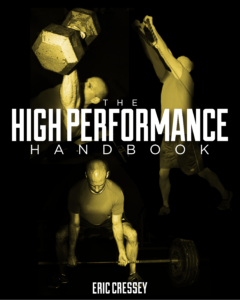
5 Strength and Conditioning Exercises that Overdeliver
One of the most popular features of The High Performance Handbook is the extensive online video database it includes. With that in mind, I thought I’d highlight a few of my favorite exercises that are included in the program. I like these, in particular, because they’re “anti-isolation” exercises. In other words, they deliver multiple training effects to give gym-goers more efficient training outcomes. Keep in mind that just because I don’t include classic compound lifts like squats and deadlifts in this discussion doesn’t mean that they aren’t absolutely fantastic; I just want to give you a little exposure to some different drills in this post.
1. Kettlebell Crosswalk
Because of the asymmetrical loading, you get some great rotary stability work at the core – on top of the anterior core stability work you get from holding a weight overhead while resisting too much arching of your lower back. You get some outstanding shoulder mobility and stability benefits, as getting the top arm up requires a lot of scapular upward rotation and rotator cuff activation. Finally, an overlooked benefit is the opportunity to reaffirm good neck positioning. A lot of athletes will want to shoot into forward head posture, but if you pack the neck correctly, you’ll be able to avoid this.
2. Positional Breathing
I use a wide variety of positional breathing drills as part of The High Performance Handbook program, so this is really more of a “category” than a specific exercise. When you put athletes (especially those with more “extended postures) into a more flexion biased position and encourage them to full exhale, you are effectively training both mobility and stability simultaneously. When you exhale, many of the muscles of inhalation – scalenes, sternocleidomastoid, lats, pec minor (not surprisingly all muscles that have chronic tissue density in many individuals) – all are forced to relax. Concurrently, the rectus abdominus and external obliques fire to get air out – and in the process, establish better anterior core stability.
Here are a few examples:
3. Dumbbell Reverse Lunge to 1-leg RDL
Whenever I put this in an athlete’s program, I go out of my way to warn them that they’ll be pretty sore in the days that follow. Lunging and 1-leg RDLs constitute different kinds of single-leg work with different training effects, but when you combine them, you can get the best of both worlds.
This can also be done with one dumbbell at a time. As athletes get more proficient with the drill, I look for more “fluid” transitions, as opposed to a lot of stop-and-go movements.
4. 1-arm KB Turkish Get-up
This one is just too obvious. To do a good get-up, you need everything from a hip hinge, to anterior core control, to shoulder mobility, to single-leg stability.
If you’re looking for a great coaching resource on Turkish Get-up Technique, check out 6 Common Turkish Get-up Technique Mistakes.
5. Combination Mobility Exercises
Let’s face it: nobody really enjoys mobility warm-ups. Fortunately, for those of you who dread these drills and prefer to get to the lifting as quickly as possible, there are some combination drills that speed up the process a bit. Check out these two examples from the program:
Wrap-up
If you’re looking to learn more about how all these different pieces fit with an overall strength and conditioning program “puzzle,” then I’d encourage you to check out my most popular resource, The High Performance Handbook. It offers programs versatile enough to accommodate a wide variety of training goals. Learn more at www.HighPerformanceHandbook.com.



